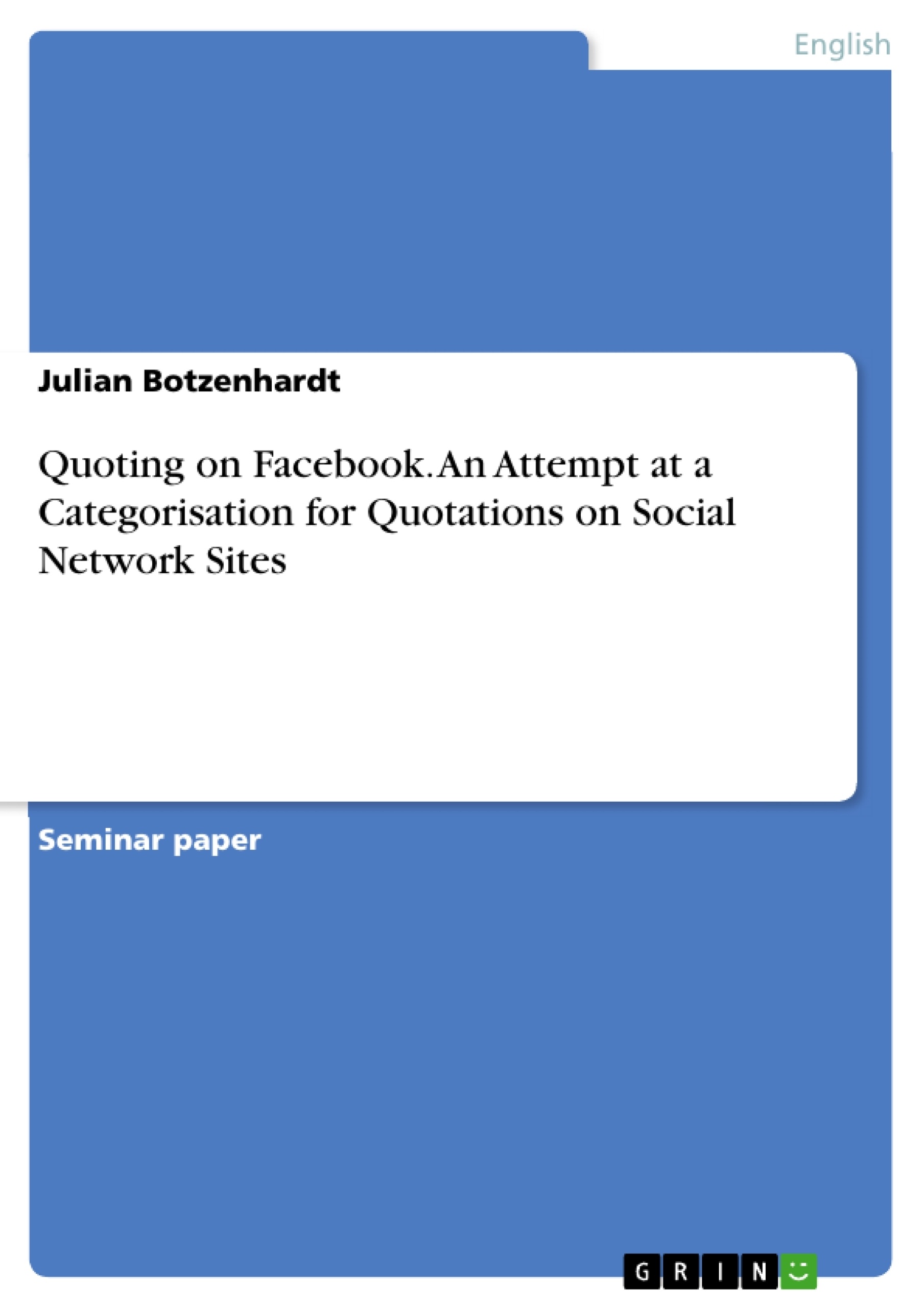According to boyd and Ellison (2007:2), “Social network sites [are] web-based services that allow individuals to (1) construct a public or semi-public profile within a bounded system, (2) articulate a list of other users with whom they share a connection, and (3) view and traverse their list of connections and those made by others within the system.” People use such services to represent their personality online, thus facilitating communication with friends and also the maintenance of social ties. Clearly, the most successful (and influential) of those networks is Facebook. Established in 2004 as an exclusive community for Harvard students, it opened for the general public in 2006 and has since then gathered over 1 billion members all across the globe, currently holding second place of the most visited websites worldwide.
Human communication has always been characterised by the recycling of language. When people talk, a great extent of the content of their discussion is devoted to what other people have already said. In doing so, speakers refer to utterances made by themselves or others inter alia by repetition and paraphrasing. They do so simply to report other people’s words but also to evaluate what has been said. Quoting has also found its way to communication media online, due to the technical properties of computer-supported environments facilitating the act of accurately reproducing a previously made statement.
Characteristically, Facebook employs mechanisms of automated text creation and distribution to support the users in making quotations. These mechanisms though, can be very complex and impenetrable. This is why I strive to provide insight into the process of quoting on Facebook in this paper. To do so, I will provide insight into the basics of the scientific field of computer-mediated communication as well as the structural principle of hypertexts in online environments. Following that, I am going to employ a newly shaped definition of the act of quoting by Bublitz in an examination of the most common text actions on the social network site Facebook. Thereby, I plan to come up with a framework of quotations on Facebook in both user-created and software-created texts.
Inhaltsverzeichnis (Table of Contents)
- Introduction
- Facebook - the user's perspective
- Communicating online: the basics of CMC
- CMC on Facebook
- Hypertexts
- Facebook as a hypertext
- How does speech work on Facebook?
- Quoting according to Bublitz
- The forms of quoting on Facebook
- The functions of quoting on Facebook
- Quoting on Facebook
- Common text actions on Facebook's Timeline
- Software authored-text actions
- User-authored text actions
- Quotations on Facebook - look who's speaking!
- Quotations in user-authored posts
- Quotations in software-authored posts
- Summary
Zielsetzung und Themenschwerpunkte (Objectives and Key Themes)
This paper examines the act of quoting on the social network site Facebook, exploring its forms, functions, and how it manifests in both user-generated and software-generated content. The analysis aims to shed light on how quoting functions within the specific context of Facebook and its unique features, considering aspects of computer-mediated communication (CMC) and hypertextuality.
- The role of quoting in online communication
- The influence of CMC and hypertexts on quoting practices
- Different forms and functions of quoting on Facebook
- Analysis of user-authored and software-authored quotes
- Implications for understanding online communication and social interaction
Zusammenfassung der Kapitel (Chapter Summaries)
- Introduction: This chapter defines social network sites and introduces Facebook as a prominent example. It then discusses the significance of quoting in human communication and explores the context of quoting within online communication.
- Facebook - the user's perspective: This chapter examines the key features of the Facebook user interface, focusing on the homepage and the personal profile. It introduces the newsfeed and the Ticker as central elements of the homepage, which play a crucial role in the dissemination of information and communication within the network.
- Communicating online: the basics of CMC: This chapter delves into the fundamental aspects of computer-mediated communication (CMC), highlighting the impact of the internet and hypertext systems on communication patterns. It defines CMC and explores its characteristics in comparison to face-to-face communication.
- Quoting according to Bublitz: This chapter introduces Bublitz's definition of quoting and its application to the analysis of quoting practices on Facebook. It examines the different forms and functions of quoting on the platform, analyzing how users employ quotes in their online communication.
- Quoting on Facebook: This chapter focuses on analyzing the various types of text actions on Facebook's Timeline, specifically distinguishing between software-authored and user-authored text actions. It explores the role of quoting in both these types of content.
Schlüsselwörter (Keywords)
This paper focuses on the phenomenon of quoting on Facebook, exploring its various forms, functions, and contexts. Key terms and concepts include computer-mediated communication (CMC), hypertext, social network sites, user-generated content, software-authored content, and the theoretical framework of quoting according to Bublitz.
- Quote paper
- Julian Botzenhardt (Author), 2014, Quoting on Facebook. An Attempt at a Categorisation for Quotations on Social Network Sites, Munich, GRIN Verlag, https://www.grin.com/document/294599



